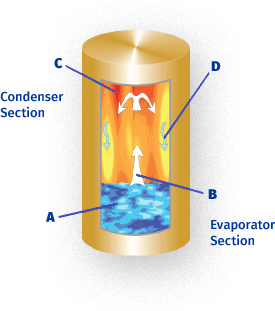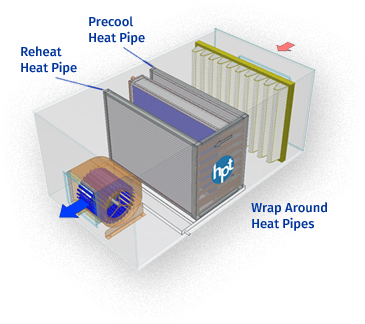Heat pipes are thermal transfer devices capable of transferring heat and energy several hundred times faster than conventional methods. A traditional heat pipe is a hollow cylinder filled with a vaporizable liquid.
How do Heat Pipes Work?
- Heat is absorbed in the evaporating section
- Fluid boils to vapor phase
- Heat is released from the upper part of cylinder to the environment; vapor condenses to liquid phase
- Liquid returns by gravity to the lower part of cylinder (evaporating section)
This process is used to improve dehumidification and recover energy from exhaust air streams in air conditioning as described below.

Using Heat Pipes to Improve Dehumidification
Heat pipes may be described as having two sections: Precool and Reheat.
The first section is located in the incoming air stream. When warm air passes over the heat pipes, the refrigerant vaporizes, carrying heat to the second section of heat pipes placed downstream. Because some heat has been removed from the air before encountering the evaporator coil, the incoming air stream section is called the precool heat pipe.
Air passing through the evaporator coil is assisted to a lower temperature, resulting in greater moisture removal. The “over cooled” air is then reheated to a desirable temperature by the reheat heat pipe section, using the heat transferred from the precool heat pipe. This entire process of precool and reheat is accomplished with no additional energy use. The result is an air conditioning system with the ability to remove considerably more moisture than regular systems.

Using Heat Pipes to Recover Energy from Exhaust to Supply Air
State of the art heat exchangers now allow for either equal calls for cool and heat recovery or optimizing thermal recovery in the season that matters most, while still allowing for appreciable recovery in the other season. Compact design, low pressure drop, high optimized season effectiveness and trouble-free operation with no moving parts, makes this product ideal for design engineers and owners alike.
Moreover, to reduce or eliminate the likelihood of any contamination of supply air, a foam-filled separation of up to 40" can be incorporated into the design. Or, a split passive system with up to 60’ of separation between air streams.



